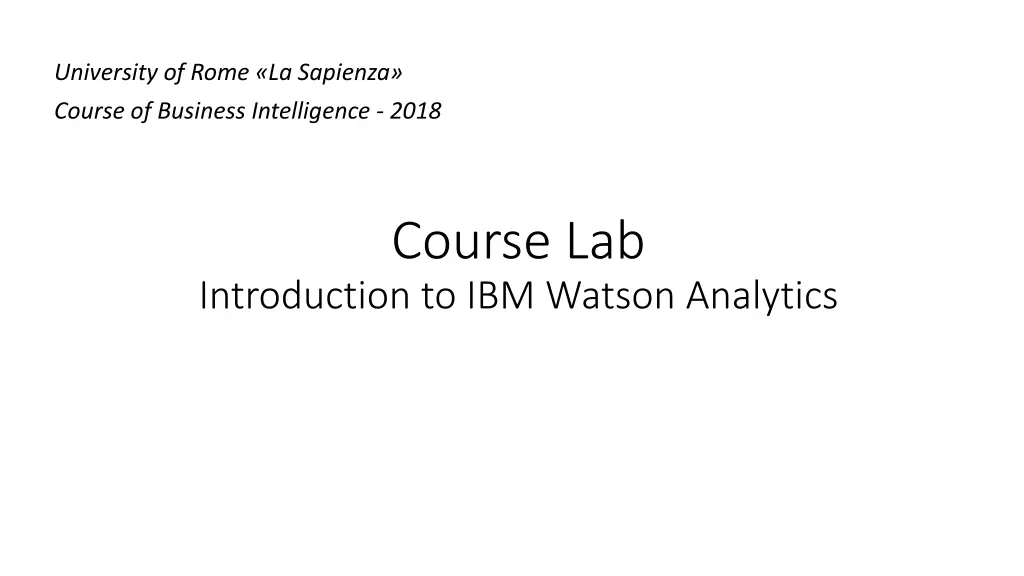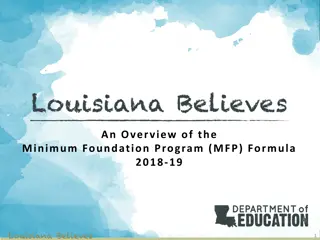
Introduction to Business Intelligence with IBM Watson Analytics
Dive into the world of Business Intelligence through a course at the University of Rome La Sapienza in 2018. Explore the use of IBM Watson Analytics, familiarize with real software used in large enterprises, and learn to accomplish significant use cases in the BI arena. Enhance your understanding of tools impacting team productivity and delve into advanced topics. Join lab sessions starting on September 27, 2018, to unleash the power of analytics.
Download Presentation

Please find below an Image/Link to download the presentation.
The content on the website is provided AS IS for your information and personal use only. It may not be sold, licensed, or shared on other websites without obtaining consent from the author. If you encounter any issues during the download, it is possible that the publisher has removed the file from their server.
You are allowed to download the files provided on this website for personal or commercial use, subject to the condition that they are used lawfully. All files are the property of their respective owners.
The content on the website is provided AS IS for your information and personal use only. It may not be sold, licensed, or shared on other websites without obtaining consent from the author.
E N D
Presentation Transcript
University of Rome La Sapienza Course of Business Intelligence - 2018 Course Lab Introduction to IBM Watson Analytics
Lab Speakers Ing. Vittorio Carullo Ing. Ivonne E. Vereau Tolino Software Architect IBM Watson Squad Senior Member v.carullo@it.ibm.com Software Engineer IBM Software Services Specialist ivonne_vereau@it.ibm.com
Target & Scope Target & Scope Familiarize with a real software used in large enterprises Accomplish small but significant use cases in BI arena Understand the impact of tools over team productivity Introduce advanced topics like the use of non structured information Lab sessions will be held on Thursday, starting from September 27, 2018 , 4 - 6 pm
Labs Labs Schedule Schedule Presentation of the tool and its basic features Lab 1: Introduction to Watson Analytics Understanding and use of the tool features or conducting BI use cases Lab 2: Working with Data Lab 3: Analyze and Discover Lab 4: Predict and take decisions Lab 5: Report and visualization Lab 6: Putting all together Use of the tool for Advanced Analytics Lab 6: Working with Social Media Lab 7: Introduction to Content Analytics Today s topic is highlighted!
Reference Reference Materials Materials Explore IBM Watson Analytics https://public.dhe.ibm.com/software/data/sw- library/analytics/watsonanalyticsgallery/ A gallery of use cases with related datasets and supporting data visualizations IBM Knowledge Center https://www.ibm.com/support/knowledgecenter/en/SS4QC9/com.ibm.sol utions.wa.doc/welcome.html A technical reference for product features
Todays Contents: Today s Contents: Putting Putting all all together together 1. Introducing Use Case 2. Working with two datasets: Data Join 3. Refine you data 4. Create Your Discoveries 5. Create you Display 6. Present results
1. Introducing Use Case
Dataset 1: The happiness score File name: 2017_World_happiness_metrics.xlsx These data have been produced by asking sampled people in several countries the following question: "How would you rate your happiness on a scale of 0 to 10 (where 10 is the happiest) ?" Then people have motivated their answers with some factors like GDP per capita, health life expectancy, freedom conditions and so on
Dataset 1 Columns Description Name Description ISO_Code 3-digit code for the exact identification of the country Country_Name Name of the country (in English) Happiness_Score An average value representing the average value of perceived happiness for population of that country GDP The extent to which GDP per capita contributes to the calculation of the score Family The extent to which Family contributes to the calculation of the score Health The extent to which Life expectancy contributed to the calculation of the score Freedom The extent to which Freedom contributed to the calculation of the score Generosity The extent to which Generosity contributed to the calculation of the score Trust_Government_ Corruption The extent to which perception of corruption of the Government contributed to the calculation of the score Dystopia_Residual The extent to which Dystopia Residual (unexplained reasons) contributed to the calculation of the score
Dataset 2: World Regions File name: world regions.xlsx These data contains the list of world countries with the region, sub- region and intermediate region they belong to: For instance: Country: Chile Intermediate-region: South America Sub-region: latin America & Caribbean Region: Americas
Dataset 2 Columns Description Name Description Name Country Name 3-Digit code ISO code of the country Region Region the country belongs to Sub-region Sub region the country belongs to Intermediate-region Intermediate region the country belongs to
What you will do today You have been asked to produce a report with two views where an user can: 1. Display the world happiness average score with the possibility to navigate through country, sub-region and region levels 2. Display a predictive model of the happiness, considering for simplicity s sake three groups: High happiness Intermediate happiness Low happiness Use the 2 XLS files presented before as work data sets
Why Data Join? Data join is handy when all data you need does not reside on a single data asset In order to join data, you need a column in common in both data assets Common columns must represent the same property, even if in different contexts Column on data set A must contains same values than dataset B (or at least a subset of them) Column names do not have to be necessarily identical
How to join / 1 Load in Refine mode the first data asset in order to display data sheet Add the second data asset by clicking on the + sign near the data set name (above column names) and selecting the one you want to join
How to join / 2 Click on the Join tool on left toolbar Connect the two columns that have to work as glue
How to join / 3 Check that joined data are displayed in the above part Save your data asset with a new name The saved asset will be displayed with a joined icon on your Data tab NOTE: in WA you can yoin only two data assets at a time
Tips and tricks/1 You have to produce a report that can be explored at different geographic levels By joining the two data assets you have been given, you will have full geo information (region, sub-region, etc) for any row Use the non-ambiguous data column to join!! Then you have to create a new column in your data asset to enable the geographic drill-down/drill-up
Tips and tricks/2 You have to produce a prediction model based on a simplified perception of happiness (three groups: low, medium, high) Then you have to create a new column in your data asset that make this possible
Tips and tricks/1 You essentially need two discoveries: a descriptive view and a predictive model (e.g spiral) You can ask questions on your data asset in order to generate automatically the two discoveries You can create the discoveries in the same discovery set and then save it When creating your views, remember that you have to display the average happiness score Since you are dealing with nations, WA could automatically display the Map view. This is obviously OK.
Tips and tricks/1 Choose the display format you prefer and put the two discoveries in it. This will be your report. You can enhance your display using icons or customizing colors You can also add filtering to your display in order to give users moer possibilities to see data
Now it is up to YOU! ENJOY! Create Discover






















